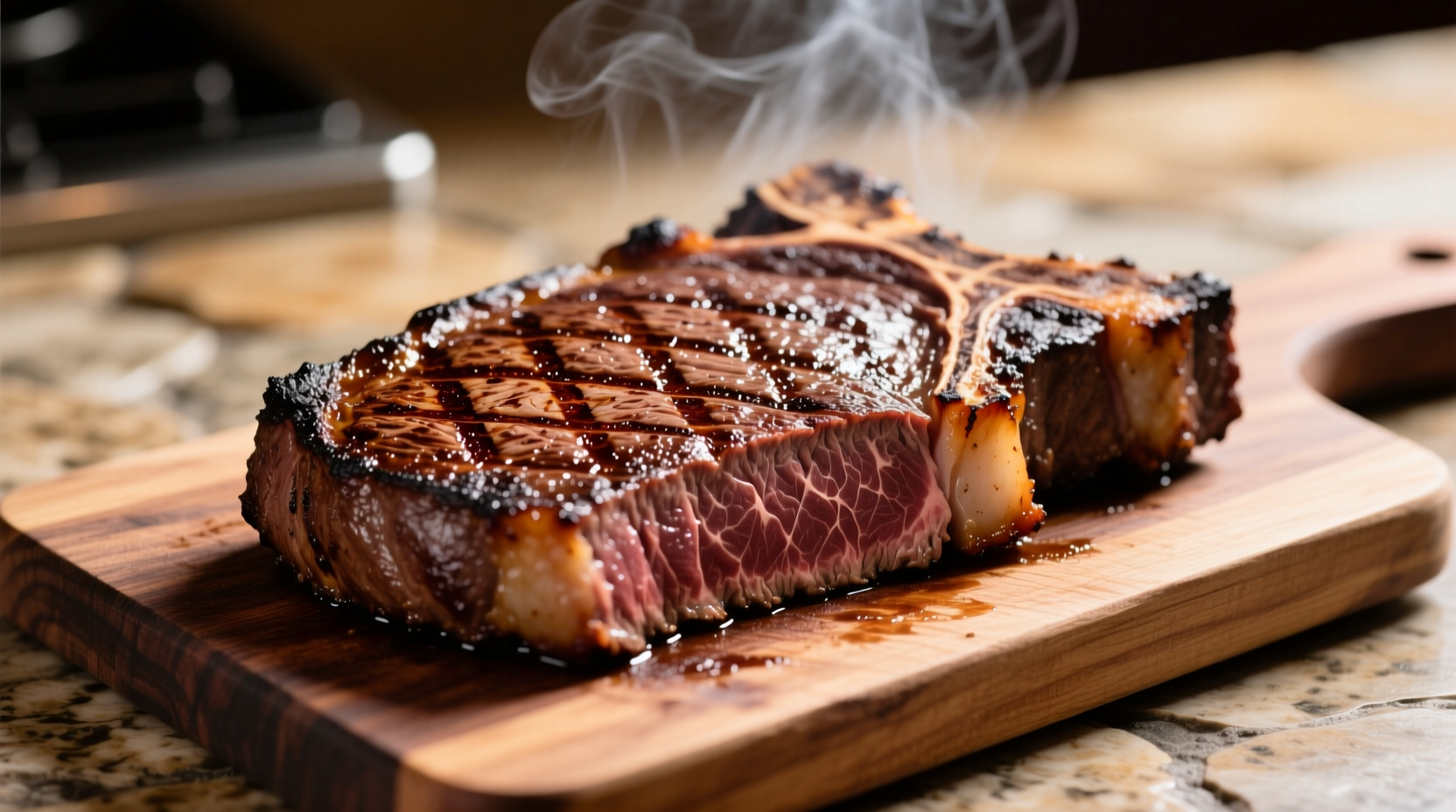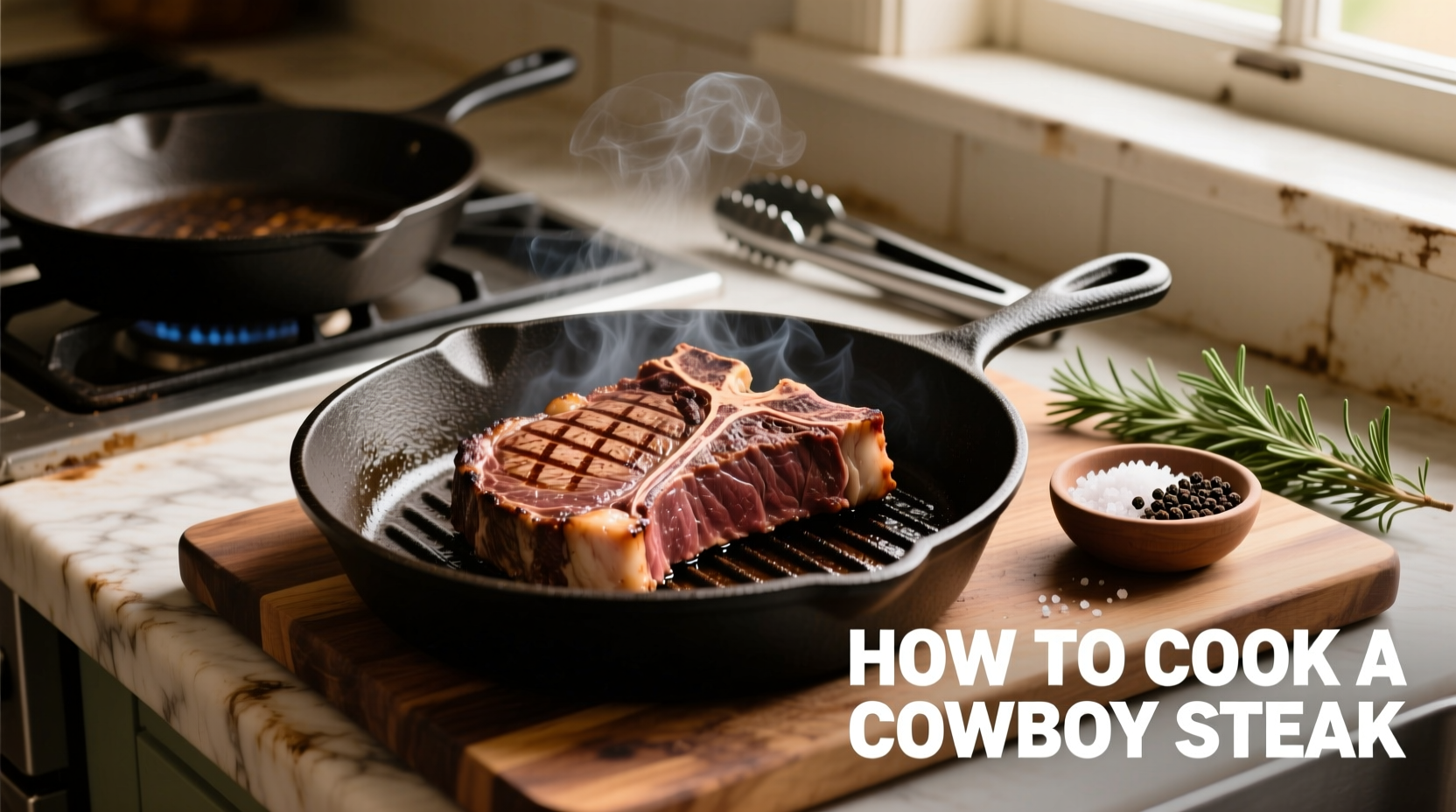Mastering the Art of Cowboy Steak Cooking
Nothing says "celebration meal" quite like a perfectly cooked cowboy steak. This impressive cut—technically a bone-in ribeye with the rib bone frenched (cleaned of meat and fat)—requires specific techniques to achieve that ideal balance of crispy exterior and juicy, evenly cooked interior. Unlike thinner steaks that cook quickly on the grill, the cowboy steak's substantial thickness demands a strategic approach to avoid the common pitfall of burnt exterior with raw center.
Why Cowboy Steak Deserves Special Attention
The cowboy steak (also called a "tomahawk" when the bone is extra long) typically measures 1.5-2 inches thick and weighs 24-48 ounces. This substantial size creates unique cooking challenges compared to standard steaks. The thick muscle fibers and generous marbling require precise temperature control to render fat properly while achieving even doneness throughout.
| Characteristic | Cowboy Steak | Regular Ribeye |
|---|---|---|
| Thickness | 1.5-2+ inches | 0.75-1.25 inches |
| Weight | 24-48 oz | 12-16 oz |
| Cooking Method | Reverse sear essential | Direct high-heat works |
| Resting Time | 10-15 minutes | 5-8 minutes |
Your Cowboy Steak Preparation Checklist
Before you even think about turning on your oven or grill, proper preparation makes the difference between good and exceptional results. Professional chefs emphasize that 70% of steak success happens before cooking begins.
Equipment Essentials
- Heavy-duty cast iron skillet or grill grate
- Oven-safe meat thermometer (Thermapen recommended)
- Wire cooling rack
- Aluminum foil for resting
- Tongs (no piercing!)
Selecting the Perfect Cut
Look for USDA Prime grade with abundant marbling—those white flecks of fat are flavor insurance. The bone should be cleaned at least 3 inches up for that dramatic presentation. Avoid steaks with grayish discoloration or excessive liquid in the packaging, which indicates improper storage.
The Reverse Sear Method: Step-by-Step
This two-stage cooking process—gentle oven roasting followed by high-heat sear—solves the fundamental challenge of thick-cut steaks. America's Test Kitchen research confirms reverse sear produces more evenly cooked results with better crust development than traditional methods for cuts over 1.5 inches thick.
Stage 1: Oven Roasting (The Foundation)
- Temperature equalization: Remove steak from refrigerator 1-2 hours before cooking. This critical step prevents the exterior from burning before the interior cooks through.
- Seasoning: Pat completely dry with paper towels, then apply 1 teaspoon kosher salt and ½ teaspoon coarse black pepper per pound. Avoid oiling—moisture prevents proper searing.
- Oven setup: Preheat oven to 275°F (135°C) with rack positioned in the center. Place steak on wire rack over baking sheet.
- Slow roast: Cook until internal temperature reaches 115°F (46°C) for medium-rare—approximately 35-50 minutes depending on thickness. This low-and-slow approach ensures even cooking from edge to center.

Stage 2: The Searing Blast (The Transformation)
- Skillet preparation: While steak roasts, heat cast iron skillet over maximum heat for 15 minutes until smoking hot. Add high-smoke point oil (avocado or grapeseed).
- Searing technique: Place steak in skillet at 45-degree angle to maximize bone contact. Sear 2-3 minutes per side until deep brown crust forms. Rotate steak to sear all edges, including the fat cap.
- Butter baste: During final minute, add 2 tablespoons butter, 2 garlic cloves, and fresh rosemary to skillet. Tilt pan and spoon melted butter continuously over steak.
Precision Temperature Guide
USDA Food Safety and Inspection Service recommends minimum internal temperatures of 145°F (63°C) for beef, followed by 3-minute rest. However, culinary professionals achieve optimal texture at lower temperatures due to carryover cooking during resting.
| Doneness | Oven Target | Final Temperature | Visual Cues |
|---|---|---|---|
| Medium-Rare | 115°F (46°C) | 130-135°F (54-57°C) | Warm red center, soft to touch |
| Medium | 120°F (49°C) | 135-140°F (57-60°C) | Pink center, springy texture |
| Medium-Well | 125°F (52°C) | 145-150°F (63-66°C) | Small pink area, firm texture |
Critical Resting Phase: Don't Skip This!
After searing, transfer steak to cutting board and tent loosely with foil. Rest for 10-15 minutes—this allows juices to redistribute throughout the meat. Cutting too soon releases precious juices onto your board rather than staying in the steak. During this time, carryover cooking will raise internal temperature by 5-10°F.
Common Cowboy Steak Mistakes
Even experienced home cooks stumble with this impressive cut. Avoid these frequent errors:
- Mistake: Skipping the dry-brine (salt application 1-2 hours pre-cook)
Solution: Salt draws out moisture initially, then gets reabsorbed, seasoning deeply and improving texture - Mistake: Using a fork to handle the steak
Solution: Tongs only—piercing releases juices that should stay in the meat - Mistake: Not rendering the fat cap
Solution: Hold steak vertically with tongs to crisp the fatty edge before final sear
When This Method Works Best (And Limitations)
The reverse sear technique excels with steaks 1.5 inches or thicker, but has context boundaries. On extremely hot days when outdoor cooking is preferred, grill masters recommend the "two-zone fire" method instead: cook over indirect heat until target temperature, then move to direct flame for searing. This approach maintains the same temperature control principles while accommodating outdoor cooking preferences.
For thinner cuts under 1.25 inches, traditional high-heat searing without oven finishing produces better results, as the reverse sear would overcook these smaller portions during the initial roasting phase.
Serving Your Masterpiece
For presentation worthy of this impressive cut, slice against the grain into ½-inch strips. Arrange slightly overlapping on a warmed platter with the frenched bone standing upright. Classic accompaniments include roasted garlic mashed potatoes and grilled asparagus, but the star should remain the perfectly cooked steak.











 浙公网安备
33010002000092号
浙公网安备
33010002000092号 浙B2-20120091-4
浙B2-20120091-4